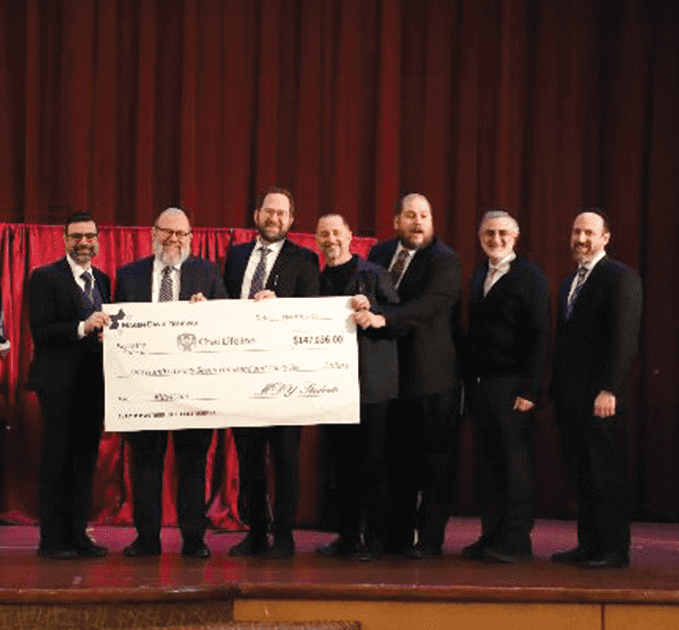ELLEN GELLER KAMARAS
“As soon as I began teaching at Magen David Yeshivah, I realized that Hashem gave me a huge gift – the ability to love all my students and see the good in them. I believe every child is special and deserves to be recognized for who they truly are. I hope this enables me to have a part in building their inner wealth for life.” ~~ Renelle ~~
Daughter of Joseph and Frieda Harary, Renelle is honored to have been in the first graduating class of Yeshiva Ateret Torah. Renelle, one of seven children, was born and bred in Brooklyn. Her grandparents were from Aleppo, Syria.
Growing up
“I was always very motivated, even as a young girl. I took music lessons, babysat, tutored, volunteered, and kept busy. Education was valued in my parents’ home, and I enjoyed learning. I read whatever I could.”
Renelle credits her parents for imbuing her with confidence and a can-do attitude.
Already a leader in high school, Renelle arranged a class in special education for her grade in their senior year, and together with a friend she persuaded their beloved principal, Mrs. Zahava Braunstein, a”h, to create a seminary year for their grade. After high school, Renelle spent her mornings learning in Ateret seminary, and her evenings attending college classes at Sara Schenirer Institute for a degree in special education. Renelle also worked in a school resource room and a special ed clinic.
Marriage and Family
At nineteen, Renelle married Rabbi David Maslaton and settled in Flatbush. The couple runs Bet Yaakov Orot Sarah together. In addition, Rabbi Maslaton teaches at Bnei Shaare Zion.
Renelle’s husband is her inspiration. “His Torah knowledge, combined with his understanding of people, serve him well in his community work.”
The Maslaton’s have three married children. The couple’s granddaughters are students of Bet Yaakov Orot Sarah, and their grandsons are in Ateret.
Renelle feels privileged to be part of our community. “It’s a true zechut to raise a family within our community, and it’s a privilege to serve our community,” Renelle stated. “A community like ours is something unique that you don’t find everywhere. Our rabbis, leaders, organizations, and the whole infrastructure of our community keep us connected, protected, and inspired!”
Renelle’s Essence
Renelle describes herself as passionate, positive, warm, loving, and devoted. I would add spiritual, confident, energetic, and capable. I was impressed by Renelle’s positive energy and attitude, and her educational views and philosophy.
Forging Her Career Path
Renelle often says that she did not choose her career, “It chose me!”
In eighth grade, Renelle wrote a report about a special education program called P’tach.
“I remember my teacher’s comment on my report, ‘Maybe this is something you’ll go into in the future!’ I laughed when I saw it because I was afraid of special needs children. I have since learned how broad and diverse the field of special education is. In ninth grade, I fell in love with high school. That year, I realized that I’d love to teach both high school and special education.”
Two female role models made a huge impression on Renelle and influenced her entry into education. Mrs. Zahava Braunstein, a”h, her high school principal, molded and shaped Renelle in her warm, wise, and loving way. “I wouldn’t be who I am without her! She was my role model in everything, and she influenced my core being in ways I only realized afterwards.”
Careerwise, Dr. Helene Ribowsky was Renelle’s most influential role model. Dr. Ribowsky is a top professional in the field of special education for students with learning differences. Renelle apprenticed with Dr. Ribowsky as much as she could, bringing students to Dr. Ribowsky’s office so she could observe the sessions.
“Dr. Ribowsky has a magical way of building up each student, of teaching them in her systematic and creative ways, and of lifting them up to meet her expectations. With a role model like her, the bar was set high! I loved watching the transformation in my students as I worked with them using her methods.”
“As far as becoming a principal, I didn’t have to look too far! Two superb principals, Mrs. Aviva Ben Haim and Mrs. Shany Gurwitz, preceded me at BYOS, and they showed me the l ropes. I still haven’t caught up yet but I hope to!”
Most of Renelle’s classroom teaching positions were at Magen David Yeshiva. “I loved the girls, the school, the administration – everything!” Renelle taught many subjects across the grades, including tefillah, marriage, Chumash, Mishle, Iyov, and ben adam li’chavero.
When she started her job at MDY, Renelle recognized the huge gift that Hashem had given her: the ability to love all her students and to see what is special and unique about each one. What excites her about her career is the thought of developing her students and helping to shape their lives.
In addition to teaching at MDY, Renelle had her own rewarding private practice in special education for fourteen years.
“I taught a boy with Down’s Syndrome from age five until he was fifteen. He attended a regular school, and he learned to read English and Hebrew, learn Chumash, Navi, Megilla, and English subjects. He was like part of my family and my children felt close to him, too. What a nahat moment when he became the assistant to the rebbe in my son’s pre-1a class last year!”
A Pivot to School Principal
When the Maslaton’s brought their oldest daughter to BYOS over twenty years ago, they were struck by the warmth of the staff.
“Did you know that music is played in the halls? Everything is done with a Syrian touch,” my friend told me. “It’s so your type, just go see.”
And today – “It’s a warm, positive, loving, and happy school. After so many years and so many students later, the warmth is still the school’s trademark.”
Approximately twelve years ago, Rabbi Maslaton was told that BYOS would be closing. He then approached Renelle with the idea that the two of them would assume the leadership roles at the school.
Renelle was hesitant. She was at a good place in life, their children were getting older, and she wanted to be more present for them. After a number of consultations with Hacham Yosef the couple decided to take the leap.
It’s no surprise that Renelle is a principal at BYOS, a school that was founded with the vision to create a Sephardic educational institution for girls that would cater to each student and family.
Renelle and parenting expert Tammy Sassoon built a social and emotional wellness program at the school, and created a unique culture that is part of the fabric of the school.
Renelle likes to say that the school is built on three pillars: spiritual, social-emotional, and academic, and in that order. “We’re passionate about each pillar and committed to excellence in each one, from nursery through high school.
“Our mission is to foster inner wealth in each girl and to provide her with the best possible opportunities so she can excel wherever life brings her, and contribute to building her home and community in a way that makes Hashem proud.”
Work-Life Balance
Renelle acknowledges that she can’t do everything, and it took years to adjust to running a school and a family. “I learned to plan weekly menus on Sunday and to prepare my shopping lists from them. I have a regular weekly order that I adjust as needed, and that gets emailed and delivered. My kids help a lot. I love having them in the kitchen with me. They are my very proficient holiday and party planners!”
Passions and Pastimes
“I have so many passions. . . about seeing the good in others, about teaching, about knowing my place…knowing that it’s not about me but is about Hashem and His children.”
Renelle strives to make her family her #1 priority. “My children are my greatest joy, challenge, vehicles for growth, and inspiration. They’re the products of our tefillot, the love, and the hinuch we give them. I’m so proud of each one!”
Renelle is passionate about Orot Sarah and adores her students, staff, and the parents. “I wake up excited to work with my amazing staff each day. There’s no place like school. And a classroom is a most magical place!”
Renelle also includes self-care in her busy life, so that she can carry out her many responsibilities with goodwill. Finally, she is passionate about learning and prays that she will always be a lifelong learner. “There’s so much wisdom that Hashem put into our world, so much to learn!”
Renelle’s special education background strongly influenced her teaching paradigm and role as principal at Orot Sarah. Her teaching philosophy (that includes the belief that kids should learn at their own level, children should not sit at a desk all day, and that the school should provide social and life skills workshops), her use of art media, creativity, and collaborative learning, were all impacted by her education and training in special education as well as her years in MDY.
“I’m humbled to see my MDY students’ daughters dancing in the halls of Orot Sarah. I’m proud of my unparalleled staff and beautiful students and their amazing growth mindset. I love when my students tell me how learning together has impacted their lives.”
Connect with Renelle at Renellemaslaton@icloud.com.
Ellen Geller Kamaras, CPA/MBA, is an International Coach Federation (ICF) Associate Certified Coach. Her coaching specialties include life, career, and dating coaching. Ellen is active in her community and is currently the Vice-President of Congregation Bnai Avraham in Brooklyn Heights She can be contacted at (www.lifecoachellen.com).












